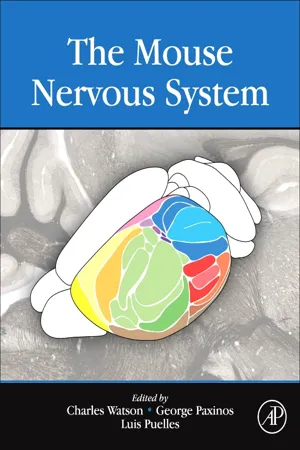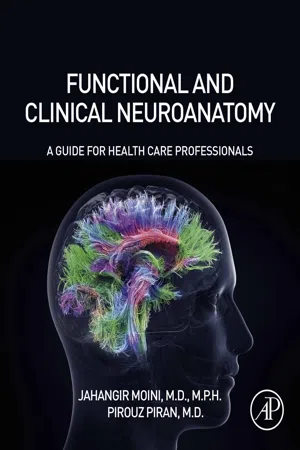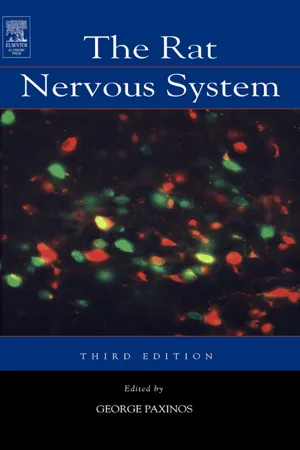Psychology
Olfactory System
The olfactory system is responsible for the sense of smell. It involves the detection of airborne chemical molecules by olfactory receptors in the nasal cavity, which then send signals to the brain for interpretation. The olfactory system plays a crucial role in detecting and identifying various scents, which can evoke strong emotional and memory responses.
Written by Perlego with AI-assistance
Related key terms
9 Key excerpts on "Olfactory System"
- eBook - ePub
- P. Michael Conn(Author)
- 2016(Publication Date)
- Academic Press(Publisher)
Chapter 17The Olfactory System
C. Trimmer1 , and J.D. Mainland1 , 21 Monell Chemical Senses Center, Philadelphia, PA, United States2 University of Pennsylvania School of Medicine, Philadelphia, PA, United StatesAbstract
Chemicals provide a rich source of information about the environment, and many animals trust their sense of smell with their most important tasks: finding prey, avoiding predators, identifying mates, marking territory, navigating their environment, recognizing kin, and establishing social hierarchies. How the Olfactory System detects and discriminates a vast number of odors, however, is poorly understood. The mammalian Olfactory System consists of a variety of subsystems distributed throughout the nasal cavity. In the periphery, a variety of receptor families detect chemicals in the environment and transduce them into neural signals. The majority of these signals pass first through the olfactory bulb where the odor is believed to be encoded as a spatiotemporal code. Higher brain areas may then pair different receptor-activation profiles into a single olfactory percept or associate the odor with nonolfactory information. Here, we examine how the Olfactory System carries out these tasks, as well as disorders that disrupt this encoding, resulting in olfactory dysfunction.Keywords
Neuroscience; Nose; Odor; Olfaction; Olfactory bulb; SensoryIntroduction
Defining the Olfactory System is not a straightforward task. Although humans tend to think of the Olfactory System as designed to detect volatile molecules and the gustatory system to detect nonvolatiles, the distinction between the two systems is based on anatomy rather than stimulus properties. In fish the Olfactory System detects molecules in solution, not in air, but fish maintain anatomically distinct olfactory and gustatory systems. The Olfactory System is not, however, a unified anatomical structure, but rather a collection of subsystems with distinct anatomy, receptor repertoires, transduction mechanisms, and central projections. All of these subsystems are united by their function: detecting chemicals in the environment and transducing them into neural signals. - eBook - ePub
- Charles Watson, George Paxinos, Luis Puelles(Authors)
- 2011(Publication Date)
- Academic Press(Publisher)
Chapter 26. The Olfactory SystemKen Ashwell
Department of Anatomy, School of Medical Sciences, The University of New South Wales, NSW, AustraliaOutline
Introduction 653Types of Olfactory Neuroepithelium 653Main Olfactory Epithelium (Regio Olfactoria) 654The Vomeronasal Organ 654Additional Olfactory Areas in the Nasal Cavity 655Olfactory Bulb 655Connections of the Olfactory Bulb 656Accessory Olfactory Bulb 657Anterior Olfactory Areas 657Lateral Olfactory Tract and Anterior Commissure 658Bed Nucleus of the Accessory Olfactory Tract 658Olfactory Ventricle and the Rostral Migratory Stream 658Conclusions 659Introduction
Olfaction and trigeminal somatosensation are the two most behaviorally important senses for mice. Olfaction plays a critical role in the recognition of predators, adult conspecifics and offspring. The olfactory input to the amygdala is central to the initiation of emotional responses, including aggression; and olfaction plays a crucial role in the formation of behaviorally important memories. Selection of suitable foods is principally based on olfactory information, while the assessment of the palatability of food once in the mouth relies on an integrated input from gustatory and olfactory pathways. The Olfactory System also has important inputs to forebrain neuroendocrine pathways, playing a key part in the regulation of reproductive and maternal behavior (Shipley et al., 2004 ).Olfactory stimuli can also activate visceral responses (salivation and gastric acid secretion) and autonomic adjustments (changes in heart rate and blood pressure). Pathways from olfactory centers to the lateral hypothalamus, amygdala, medial frontal and insular cortex may be involved in mediating these far-reaching influences. Olfactory information may also influence motor pathways through the ventral striatum.Types of Olfactory Neuroepithelium
The olfactory epithelium of the nasal cavity is the site of transduction of odorant information into coded neural signals. The olfactory epithelium in rodents is traditionally divided into two broad regions. The first of these divisions (main olfactory neuroepithelium or regio olfactoria of the nasal cavity) is a topographically complex, folded sheet extending across the endo- and ectoturbinates, upper nasal septum and cribriform plate region. Additional, topographically discrete, olfactory areas in the rostroventral nasal septum (e.g. septal organ of Masera) show similar expression of neuronal markers to the main olfactory epithelium (Weiler and Benali, 2005 - eBook - ePub
- James R. Augustine(Author)
- 2016(Publication Date)
- Wiley-Blackwell(Publisher)
CHAPTER 17The Olfactory and Gustatory Systems- 17.1 THE Olfactory System
- 17.2 THE GUSTATORY SYSTEM
- FURTHER READING
The perception of visual, auditory, and olfactory stimuli is based on the concept of object recognition. In this regard, an “object” is something that we encounter in the world around us that is presented to one of our special sensory systems. For example, light reflecting off of a banana creates a visual object representation of the banana in our brain. Similarly, odorant molecules – perhaps tens or hundreds of them from a banana – collectively create an olfactory object representation of a banana in our brain, even in the face of a continually shifting olfactory background. Even though odors in our environment are complex and variable, the human Olfactory System is able to recognize, categorize, and discriminate them as olfactory objects (Gottfried, 2010). As is the case with other special senses, olfaction declines with age.17.1 THE Olfactory System
Olfaction or the sense of smell is a chemical sense. This implies that there is a relationship between the chemical structure of a substance and its smell (or taste). Humans are able to detect and discriminate thousands of odors, judge odor strength (weak, moderate, or strong), and describe the pleasurable aspects or hedonics of odor (unpleasant, indifferent, or pleasant). At strong intensities, many odors are usually considered pleasant or unpleasant. This is likely a result of over‐stimulation or “overdriving” of the Olfactory System. In our real‐world environment, most odors are complex mixtures of dozens or perhaps hundreds of different odorant molecules.In comparison with animals, humans are microsomatic, having limited ability to use olfactory clues. In general, women probably have better olfactory acuity then men. Variations in olfactory acuity occur during the menstrual cycle. Such acuity is highest at ovulation and lowest at menstruation. Fluctuations in olfactory sensitivity during the menstrual cycle are probably due, in part, to elevated blood estrogen levels, which often lead to changes in the olfactory mucus layer that limits access of certain odorant molecules to the olfactory receptors. - eBook - ePub
Functional and Clinical Neuroanatomy
A Guide for Health Care Professionals
- Jahangir Moini, Pirouz Piran(Authors)
- 2020(Publication Date)
- Academic Press(Publisher)
The limbic system is one of the most complicated structures in the brain. It is involved in homeostasis, memory, emotions, olfaction, and many other psychologic functions. This system includes the amygdala, septal nuclei, cingulate cortex, and many other structures that reach the forebrain, midbrain, lower brainstem, and the spinal cord. The limbic system is highly complex, since it connects with the neocortex and central nuclei and utilizes many different neurotransmitters. The Olfactory System utilizes olfactory (receptor) cells, sustentacular (supporting) cells, and basal cells. It sends information through cranial nerve I to the brain, and handles the sense of smell. Olfactory receptors can respond to many different odorants. The sense of smell is crucial in order for the sense of taste to function properly. There are many different conditions that affect the limbic, olfactory, and gustatory systems, which will be discussed in detail in this chapter.Limbic system
The limbic system is an extensive neural network. It handles emotions, memory, homeostasis, motivations, unconscious drives, and olfaction. It is highly complex, making the study of this system clinically difficult. Advances in behavioral studies, deep-brain stimulation, perfusion, and functional magnetic resonance imagings (MRIs) have allowed better understanding of the limbic system.Anatomy of the limbic system
The limbic lobe contains the structures of this system. They include the following:- • Amygdala —also called the amygdaloid nuclear complex ; fear and emotion center
- • Various hypothalamic nuclei —involved in homeostasis; hunger, satiety, thermoregulation, and sleep onset
- • Olfactory cortex
- • Septal nuclei —below the rostrum of the corpus callosum
- • Nucleus accumbens —a region in the basal forebrain, rostral to the preoptic area of the hypothalamus
- • Hippocampal formation —mainly involved in memory
- • Cingulate cortex —in the medial aspect of the cerebral cortex
- • Areas of the basal ganglia —at the base of the forebrain and top of the midbrain
- • Ventral tegmental area —close to the midline, on the floor of the midbrain
- • Limbic midbrain areas —including the periaqueductal gray matter
The limbic brain includes all of these structures as well as their projections, which reach the forebrain, midbrain, lower brainstem, and the spinal cord limbic systems (Fig. 15.1 ). These spinal systems are reached mainly via the fornix, stria terminalis, ventral amygdalofugal pathway , and mammillothalamic tract - eBook - ePub
- George Paxinos(Author)
- 2004(Publication Date)
- Academic Press(Publisher)
CHAPTER 29 Olfactory System Michael T. Shipley, Matthew Ennis, Adam C. Puche Department of Anatomy and Neurobiology, University of Maryland School of Medicine, Baltimore, Maryland, USA The Olfactory System is important for reproductive/maternal functions, neuroendocrine regulation, emotional responses, aggression, and the recognition of conspecifics, predators, and prey. Olfaction also plays a critical role in food selection, as the perception of flavors results from the integration of olfactory and gustatory signals. The prepotency of olfactory stimuli in memory and the control of animal behavior have long been recognized, yet the neural mechanisms that underlie the perception of “smell” are still poorly understood. Since the previous edition of this volume, significant advances have been made in our understanding of the molecular and cellular physiology of olfaction. Odor molecules are transduced by olfactory receptor neurons (ORNs), first-order neurons located in the olfactory epithelium within the nasal cavity (Fig. 1). ORNs are both the receptors that transduce odors and the first-order neurons that convey information to subsequent neurons in the olfactory network. ORN axons project in the olfactory nerve to synaptically terminate in the main olfactory bulb (MOB). MOB output neurons, mitral and tufted cells, convey olfactory information to higher order olfactory structures and to other brain systems. Transmission from the nose to the mitral and tufted cells is strongly regulated by local intra-bulbar circuitry and by centrifugal inputs to the MOB from other parts of the brain. Higher order olfactory structures targeted by the mitral and tufted cells include, from rostral to caudal, the olfactory peduncle (anterior olfactory nucleus), piriform cortex, olfactory tubercle, entorhinal cortex, and some amygdaloid nuclei - eBook - ePub
Flavour
From Food to Perception
- Elisabeth Guichard, Christian Salles, Martine Morzel, Anne-Marie Le Bon, Elisabeth Guichard, Christian Salles, Martine Morzel, Anne-Marie Le Bon(Authors)
- 2016(Publication Date)
- Wiley-Blackwell(Publisher)
Chapter 1 Olfactory System in mammals: structural and functional anatomy Anne-Marie Le Bon, Frédérique Datiche, Jean Gascuel & Xavier GrosmaitreCenter for Taste and Feeding Behaviour, CNRS, INRA, University of Bourgogne Franche-Comté, Dijon, France1.1 Introduction
The survival and reproductive success of living organisms, including human beings, depends on the detection of sensory stimuli. Living organisms do not eat or reproduce with whatever is available; instead, they show considerable selectivity by taking advantage of their chemical and physical senses. In this regard, the sense of smell and its capacity to detect myriad of odorant molecules is of critical importance for humans and most animal species. This sense significantly contributes to the identification of food and assessment of its palatability, as well as to the detection of chemical compounds carrying specific information concerning dangers, social interactions and reproductive behaviours. In mammals, these diverse roles are accomplished by a complex Olfactory System. The primary tissue responsible for sensing volatile odorants is the olfactory epithelium (OE) which is localized in the nasal cavity. Sensory neurons residing in the OE convey olfactory information to the olfactory bulb (OB) which, in turn, transfers this information towards multiple higher cortical regions collectively referred to as the olfactory cortex. Other olfactory subsystems such as the vomeronasal organ coexist with the main OE in many species. These subsystems are separate entities that are dedicated to distinct functional roles.The principal aim of this review is to gather the results of very recent as well as major studies on the processing of olfactory information by the Olfactory System and to highlight its plasticity. We first describe the physiology of the main OE and the molecular mechanisms of odorant detection. We then show how endogenous and exogenous factors may induce different forms of plasticity of the OE. We also outline the main features of other olfactory subsystems. Next, we examine how the olfactory signal generated at the peripheral level is transformed at the first processing center in the brain, the OB. Finally, we provide an overview of the higher olfactory pathways involved in the processing of olfactory information and we consider the pathways that shape odour perception. - (Author)
- 2018(Publication Date)
- Wiley(Publisher)
Most humans mistrust their sense of smell as a fickle and imprecise system when compared with vision or audition. In stark contrast, most mammals rely upon it for many crucial tasks—identifying food, avoiding predators, and finding mates. Due to the human bias toward vision and audition, olfaction is, in many respects, a poorly understood sense. While we have electronic devices that can record and reproduce images and sounds, we have not developed devices that can do either reliably for odors. This is due to a number of issues, including the fact that odor space is vast and we have very little understanding of its inherent organization, as well as the fact that these molecules are sensed by a sprawling set of receptors. These features make the study of olfaction both challenging and rewarding. Recent discoveries in molecular biology and advances in optogenetics suggest that the tools may be at hand to decipher the olfactory code. These advances, however, require a solid grounding in human psychophysics. Indeed, compared to the study of vision and audition, the study of olfaction has an unusual trajectory. Research in the former modalities initially focused on human behavioral phenomena and then successively added work from electrophysiology as it came online, followed by molecular biology and genetics as these disciplines developed. In contrast, the Olfactory System defied many early attempts to organize the stimulus space and make sense of its neural properties. The central foothold came from the discovery of the olfactory receptor repertoire and the breathtaking organizational structure of the olfactory bulb that was revealed only through genetic constructs (Buck & Axel, 1991; Mombaerts et al., 1996). This led many to use the organization of the olfactory bulb input to infer systems‐level organization, but this is unlikely to lead to an understanding of odor coding without more human psychophysical data.This chapter begins by describing the olfactory stimulus and then moves to a discussion of the anatomy of the Olfactory System from the nasal cavity to the central nervous system. This structural description is followed by an examination of the basics of sensory processing, a description of standard methods for studying olfaction, and an overview of basic results from psychophysical analyses. The psychophysics of olfaction is followed by a review of olfaction in higher‐level cognition, and the chapter concludes by describing clinical dysfunction in olfaction. We will focus, when possible, on the main Olfactory System of humans, with some supporting data, largely from mammals.THE OLFACTORY STIMULUS
The mammalian Olfactory System detects volatile molecules in the environment. Molecules are combinations of atoms held together by chemical bonds, but given that there are over 100 types of atoms and many suitable rearrangements of these atoms, the number of possible molecules is enormous. Most of the molecules we smell, both in nature and created synthetically by chemists, are made from only five types of atoms: carbon, hydrogen, oxygen, nitrogen, and sulphur. Not surprisingly, these are also the most common molecules in organic chemistry. More rarely, an odor will contain chlorine, bromine, or iodine. Molecules with other atom types are capable of having an odor, but are rarely encountered in the natural environment. To narrow this chemical space down to odor space, we can also eliminate all molecules that cannot reach the olfactory receptors, which are located in the dorsal nasal cavity and bathed in an aqueous layer of mucus. Figure 4.1- eBook - ePub
- Andreas Keller(Author)
- 2017(Publication Date)
- Palgrave Macmillan(Publisher)
So far, I have discussed the perception of perceptual qualities. I have also explored how these qualities can be combined in time and space, whether these combinations amount to something like perceptual objects, and what the function of perceiving and combining perceptual qualities is. Throughout, I have pretended that perception is separate from other cognitive processes and that the different perceptual modalities are not connected. Now I will acknowledge that the distinction between perceptual and non-perceptual processes is largely arbitrary. Therefore, a satisfying account of olfactory perception has to include an analysis of the relation between olfaction and non-perceptual cognitive processes, as well as of the relation between olfaction and other perceptual modalities.In Chap. 5 , I will discuss the flow of information from the Olfactory System to cognitive processes. I will argue that emotional processes have privileged access to olfactory information whereas the connection between olfaction and language is weak. I will contrast this finding with the availability of visual information throughout the mind and argue that the connection between olfaction and emotional processes reflects the evolutionary history of olfactory perception. Because each modality has a different evolutionary history, it is not possible to generalize from the connectivity observed in one modality to the connectivity of all other modalities.In Chap. 6 , I will then address the flow of information from other parts of the mind towards the Olfactory System. I will first discuss the flow of information from cognitive processes towards olfaction, a process often called cognitive penetration of perception. In the second part of Chap. 6 - eBook - ePub
Sensory Marketing
Research on the Sensuality of Products
- Aradhna Krishna, Aradhna Krishna(Authors)
- 2011(Publication Date)
- Routledge(Publisher)
Rolls, 1999 ). None of our other senses have this direct and intimate connection with the areas of the brain that process emotion, associative learning, and memory.In addition to the distinctive neuroanatomical connection between olfaction and emotion, olfaction and emotion are deeply connected by neuroevolution. The structures of the limbic system (e.g., the amygdala and hippocampus) evolved out of tissue that was originally olfactory cortex. That is, the emotional and associative learning substrates of the brain grew out of tissue that was first dedicated to processing the sense of smell. Something to ponder is whether or how we would experience emotion if we did not have a sense of smell. Furthermore, the informational significance of emotion and olfaction is functionally the same. The most immediate responses we have to an odor are simple binary opposites: like or dislike, approach or avoid. Emotions convey the same message: approach what is good, joyful, loving; avoid what is bad, fearsome, or liable to cause grief. Thus emotions and olfaction are functionally analogous. Both enable the organism to react appropriately to its environment, maximizing its chances for basic survival and reproductive success. It is my opinion that the human emotional system may be a highly evolved, cognitive version of the basic behavioral motivations instigated by the Olfactory System in animals (Herz, 2000 , 2007 ).Experimental Evidence for Odor-Associative Learning in Preference Formation
Indirect evidence supporting the central role of emotion in odor-associative learning has been shown in several studies. For example, in an experiment assessing autonomic emotional responses to odors it was found that eugenol (“clove” odor used in dental cement) was rated as very unpleasant and elicited autonomic reactions indicative of fear among patients who were afraid of dental procedures. While, by contrast, participants who did not have a history of negative dentistry experiences evaluated eugenol positively and showed neutral autonomic responses (Robin, Alaoui-Ismaili, Dittmar, & Vernet-Mauri, 1998
Index pages curate the most relevant extracts from our library of academic textbooks. They’ve been created using an in-house natural language model (NLM), each adding context and meaning to key research topics.








